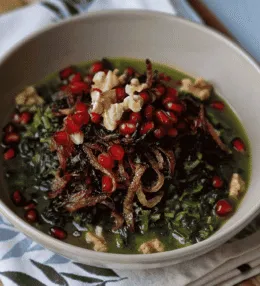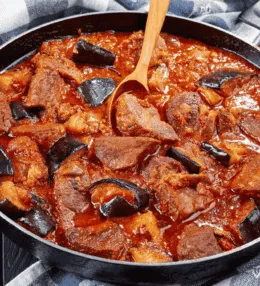
- View
Table of Contents
ToggleMoules Frites is a Belgian dish, a perfect harmony of the sea and the land that has become a national treasure. Found in bustling brasseries, charming seaside cafés, and home kitchens across Belgium, this dish captures the essence of Belgian culinary tradition, simple, satisfying, and steeped in history.
Moules Frites is a celebration of fresh mussels steamed in a flavourful broth, served alongside golden, crispy fries. Whether enjoyed as a casual meal or a restaurant specialty, it remains one of Belgium’s most iconic and beloved dishes.
Want to dive deeper into Belgian Cuisine? Don’t miss our post on 19 Traditional Belgian Foods to Try
What Is Moules Frites?
Moules Frites is a classic combination of mussels and fries, served together as a main course. The mussels are typically cooked in a light, aromatic broth, allowing their natural sweetness to shine through.
They are often served in a deep pot, their shells slightly open, revealing plump, tender morsels bathed in a fragrant sauce. The accompanying fries, or frites, are fried to a crisp perfection, their golden exteriors giving way to soft, fluffy centres.
Despite its elegant simplicity, there are countless variations of Moules Frites across Belgium. The most popular preparation, Moules Marinières, features mussels cooked in a white wine and butter sauce with shallots, garlic, and parsley.
Other regional twists include Moules à la Crème, which adds cream for a richer texture, and Moules à la Provençale, which incorporates tomatoes and herbs for a Mediterranean flair.
No matter the variation, the essence of Moules Frites remains the same; briny, tender mussels paired with crisp, golden fries for the ultimate contrast in textures.
Ingredients and Taste
At the heart of Moules Frites are high quality ingredients that allow the dish to shine. Fresh mussels are essential, ideally harvested from the North Sea, where they develop their signature plumpness and delicate sweetness.
The broth is typically built with white wine, butter, shallots, garlic, and fresh herbs, creating a balance of richness and brightness. Some versions include leeks or celery for added depth, while others introduce cream for a silkier finish.
The fries, or Belgian frites, are a point of national pride. Unlike ordinary fries, they are traditionally double fried, first at a lower temperature to cook them through, then at a higher heat to achieve the perfect crunch.
They are served with a side of mayonnaise, a Belgian staple that adds a creamy contrast to the crispness of the fries. Together, the mussels and fries create a dynamic pairing.
The mussels are tender and briny, infused with the flavours of their cooking broth, while the fries provide a crispy, salty bite that complements the dish beautifully. The result is a meal that feels both indulgent and light, satisfying without being heavy.
A Taste of History
The origins of Moules Frites trace back to the Belgian coast, where mussels have been a staple since the middle Ages. With their abundance in the North Sea, mussels were an accessible and affordable source of protein for coastal communities.
Meanwhile, the history of Belgian frites dates back centuries, with records suggesting that villagers in the Meuse Valley were frying potatoes as early as the late 17th century.
When fish were scarce in winter, locals would slice potatoes into small pieces and fry them as a substitute. The pairing of mussels and fries as a single dish, however, is believed to have gained popularity in the 19th century.
Street vendors in Brussels and other cities began serving mussels alongside frites, recognizing how well the two complemented each other. Over time, Moules Frites became a national dish, deeply ingrained in Belgian food culture.

Belgian Moules Frites (Mussels with Fries)
Equipment
- Deep fryer or large pot for frying
- Dutch oven or large pot for mussels
- Slotted spoon
- Knife and cutting board
- Wire rack
- Bowls for serving
Ingredients
For the Mussels:
- 2 kg 4.4 lbs fresh mussels, cleaned and debearded
- 2 tbsp unsalted butter
- 2 shallots finely chopped
- 3 cloves garlic minced
- 250 ml 1 cup dry white wine
- 250 ml 1 cup fish or vegetable broth
- 1 bay leaf
- 2 sprigs fresh thyme
- 1 small bunch fresh parsley finely chopped
- Freshly ground black pepper to taste
- Lemon wedges for serving
For the Fries (Frites):
- 4 large russet potatoes peeled and cut into 1 cm (⅓ inch) thick fries
- 1 litre 4 cups vegetable oil, for frying
- Sea salt to taste
Instructions
- Rinse the mussels under cold water, scrubbing the shells and removing any beards. Discard any open or cracked mussels that do not close when tapped. This ensures only the freshest mussels make it to the pot.
- Peel the potatoes and cut them into uniform fries. Soak them in cold water for at least 30 minutes to remove excess starch, resulting in crispier fries.
- Heat the vegetable oil in a deep fryer or heavy bottomed pot to 140°C (285°F). Drain and pat the potatoes dry with a kitchen towel. Fry them in batches for 4-5 minutes until pale and slightly softened. Remove with a slotted spoon and let them rest on a wire rack.
- In a large pot or Dutch oven, melt the butter over medium heat. Sauté the shallots and garlic until fragrant and translucent, about 2 minutes. Stir frequently to prevent burning.
- Pour in the white wine and fish broth, then add the bay leaf and thyme. Bring the liquid to a gentle simmer. The wine adds depth, while the herbs infuse the broth with aromatic flavours.
- Increase the heat to high and add the cleaned mussels. Cover with a tight fitting lid and steam for 5-7 minutes, shaking the pot occasionally. The mussels are ready when they open. Discard any that remain closed.
- While the mussels cook, increase the oil temperature to 180°C (350°F). Fry the pre-cooked fries in batches for another 2-3 minutes, until golden and crisp. Drain on paper towels and sprinkle with sea salt.
- Remove the mussels from the heat. Discard the bay leaf and thyme sprigs, then stir in freshly chopped parsley. Ladle the mussels and broth into serving bowls.
- Serve the mussels immediately with a side of crispy fries and lemon wedges. Traditionally, moules frites is accompanied by mayonnaise or aioli for dipping.
- Pair this dish with a chilled Belgian beer or a crisp white wine. Serve in deep bowls with an extra empty dish for discarded shells. Encourage diners to enjoy the broth by sipping or soaking it up with bread.
Nutrition
You May Also Like






